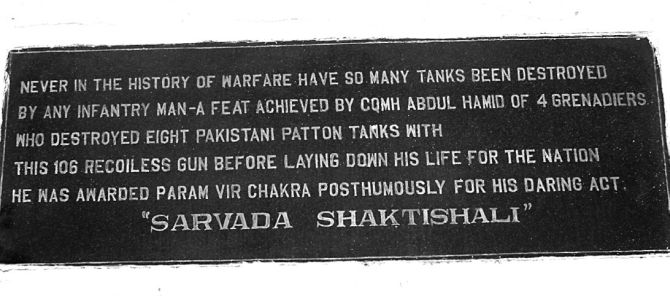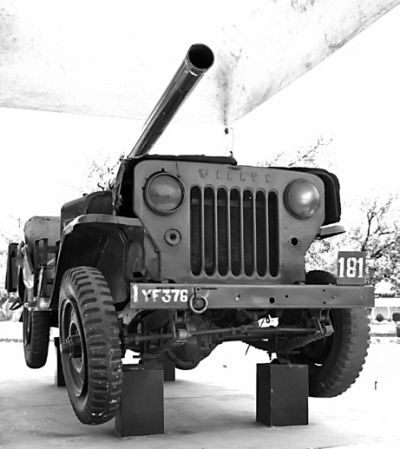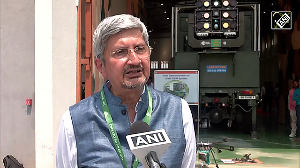
'Both Abdul Hamid and the enemy tank place each other in their sights and shoot. Both shells hit their targets. There is a loud blast, fire and smoke.'
'Abdul Hamid is dead. He has destroyed a total of seven enemy tanks, many more than what an armoured formation could take on.'
Rachna Bisht Rawat salutes Abdul Hamid's incomparable courage in the 1965 War.
An exclusive excerpt from her new book, 1965: Stories from the Second Indo-Pak War (Penguin Viking).
8 September, Khem Karan sector
9 am.
CQMH (Company Quarter Master Havildar) Abdul Hamid sits in the co-driver's seat of his jeep which has a recoilless gun mounted on it, and as he passes through the sugar cane fields, he can hear the rustling wind in his ears.
The jeep trundles over a narrow mud track ahead of Chima village. He knows Pakistan had launched an attack with a regiment of Patton tanks and has barged right into the forward position.
He hears the rumble of armour first and then catches sight of a few Pakistani Patton tanks that are heading in the direction of his battalion. Taking cover behind the tall crop, he points his gun in their direction and waits.
The Grenadiers hold their fire so as not to warn the enemy. Just as the tanks come within shooting distance, Hamid asks his loader to load the gun and fire.
He watches the shell as it shoots out and arches towards the first enemy tank. Even as he picks up his binoculars, he hears the blast. The tank goes up in flames in front of his eyes.
Hamid and his men rejoice. 'Shabaash! (Bravo!)' he mouths and they exchange wide smiles. They spot the crew of the two following tanks dismount and flee. He orders the jeep driver to reverse and move.

Photograph: Kind courtesy, 1965-Stories from Second Indo-Pak War by Rachna Bisht Rawat.
Around 11.30 am, the battalion is subjected to heavy artillery shelling. Soon after, they hear the familiar rumble again. Hamid whips out his binoculars.
Three more tanks are heading in their direction. He asks his driver Mohammad Naseem to position his jeep in the middle of the field so that it is hidden from view and, adjusting his weapon, he waits.
The moment the tank comes within shooting distance, he signals to the loader and watches the trajectory of the shell. It hits its target and one more tank is aflame in front of his eyes, while the remaining two are again abandoned by the Pakistanis.
By the end of the day, Hamid has destroyed two tanks, while four have been abandoned. They call on the engineers to immediately lay out anti-tank mines in the area as that is where the enemy tanks are coming from.
They do the best they can in the little time available. It is clear that the battalion is facing a Brigade-level attack from the Pakistani armoured forces and all they have to fight them with are recoilless guns.
That doesn't daunt the soldiers who are in high spirits after their initial victories.

Photograph: Kind courtesy, 1965-Stories from Second Indo-Pak War by Rachna Bisht Rawat.
The next morning Hamid is back at his recoilless gun. The battalion also faces an air attack from Pakistani Sabre jets but these don’t do much damage.
By the end of the day, he and his team have shot down two more tanks -- a remarkable achievement. That night Hamid sleeps peacefully. His citation, crediting him with the destruction of four tanks, has been sent for the award of Param Vir Chakra.
The following day he shows up on the battlefield yet again, to destroy as many as three more tanks; however, these will not enter his records as his citation has already been sent.
On 10 September, 4 Grenadiers comes under heavy enemy shelling. After that there is another assault by enemy tanks. They are moving in a formation of three. Hamid lies in wait, hidden by the thick vegetation and, when the first tank gets close, he blows it up, quickly asking his driver Naseem to move away.

Photograph: Vijay Dandapani.
Just as they do, a tank shell bursts at the very spot where they were a few minutes back. By then the brave Grenadiers have moved to another point behind a thicket of babool trees, from where they are training their gun on another Patton.
They shoot down one more Patton. By now, the shelling has started. The tanks have noticed the RCL jeeps and they start raining down concentrated machine-gun fire on them.
Hamid is tricking them by constantly changing his position and keeping his jeep camouflaged amidst the tall cotton crop growing in the fields. Another tank is slowly lumbering towards him and he does not have time to move since they have both spotted each other.
He tells his driver and loader to jump off. 'Hum kapas ke khet mein kude aur roll hokar nale mein ludak gaye (We jumped into the cotton field and rolled into a drain),' says Naseem.

Photograph: Kind courtesy, 1965-Stories from Second Indo-Pak War by Rachna Bisht Rawat.
Both Hamid and the enemy tank place each other in their sights and shoot. Both shells hit their targets. There is a loud blast, fire and smoke. At the same moment that the tank is blown up, its shell hits the RCL jeep.
Hamid doesn't get time to jump off. A deafening blast follows and then there is complete silence.
CQMH Hamid is dead. He has destroyed a total of seven enemy tanks, many more than what an armoured formation could take on.
For his remarkable achievement, bravery and courage, CQMH Abdul Hamid is awarded the Param Vir Chakra posthumously. The battalion is awarded the Battle Honour Asal Uttar and the Theatre Honour Punjab.
It is a first in military history that a battalion armed with nothing more than recoilless guns has fought off an armoured division.
Excerpted from 1965: Stories from the Second Indo-Pak War by Rachna Bisht Rawat. Penguin Viking, with the publisher's kind permission.
Our Special Series: The 1965 War, 50 Years Later
- My salute to arguably India's greatest military hero
- My Father, the Param Vir Chakra Winner
- Two wars and a romance
- The war that helped India regain its military confidence
- The central lesson from the '65 war
- The general who saved Punjab in the '65 war
- You can buy Rachna Bisht Rawat's The Brave, Param Vir Chakra Stories here.











 © 2025
© 2025